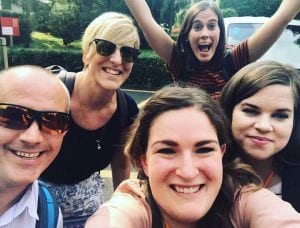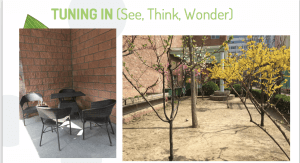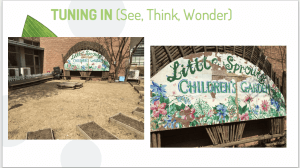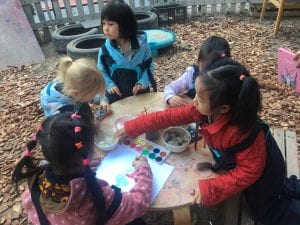This weekend I travelled to Shenzhen, China to the ACAMIS ECE conference with some of our amazing Early Years teachers. We all decided in the spring to take a risk and apply to present at the conference and our proposals were accepted. I presented with two teachers passionate about outdoor learning about our experience in transforming our outdoor learning spaces.
Our presentation was titled Reimagining What is Possible: Urban Outdoor Learning Spaces. In our presentation we shared our journey at CISB to transform our limited spaces into opportunities for our students and families to engage with nature and the outdoors. This project grew out of our SMART goal groups from last year, teacher passions and agency.
How did this process unfold?
Silvia was a passionate PK4 teacher who believed strongly in providing opportunities for students to develop and make meaning from exploring their passions and curiosities to make meaning of their world. She had a very child centered classroom in which her students drove the learning.
Kevin is our nature nerd and believes strongly in developing a sense of responsibility and stewardship in our students for the environment and all things related nature. He founded the CISB Nature and Conservation Club with students .
I believe strongly as a leader in developing teachers’ passions and encouraging them to take risks and agency to implement changes in our community and our school in an effort to improve and support student learning and the growth and development of the whole child.
We began to notice a few things:
>Students had a curiosity about nature
>Students had a desire to explore their environment
>Students were wondering about the outdoors and how things functioned in the natural world.
>Students had very few opportunities to take risks and explore the natural world
>Parents did not value time in the outdoors playing and exploring. They were more concerned with academic achievement.
>Parents themselves did not have experience in the outdoors.
>Students were afraid of bugs and getting dirty.
>Many of our children struggled with the idea of play. They were often only children and had been protected and not encouraged to explore their passions or curiosities. They participate in solitary activities and are catered to by all of the adults in their lives: parents, grandparents, Ayis.
Our teachers came together in SMART goal groups and identified 3 areas related to outdoor learning that they wanted to explore and change.
Adding Loose Parts to play.
Creating a designated space for authentic outdoor learning: Mud Kitchen, Music and Water area.
Creating a pollinator garden and other areas in which students would be able to see the growth and changes in plants and insects.
Teachers began examining the spaces that we had and asking questions:
What spaces do we have?
How can we use them?
What will it take to transform these environments?
Where can we start?
How do we prioritize?
How do we divide the planning?
How do we design the spaces?
What do we need?
Who do we need to involve?
This was a completely teacher led initiative. As the principal I simply created the conditions for teachers to act, asked the difficult questions, involved the necessary departments, supported their efforts, advocated for our needs and helped others in the organization to see the value in what we were trying to do for our students.
One of the key changes that I did make was to reorganize the Early Years specialties and the way they were delivered. I really felt that if we were going to identify outdoor learning as a priority we needed to create a position in Early Years in which a staff member would take on the responsibility as Outdoor Learning and Art integrator. I also reorganized the timetable and insisted that all of our students in PreK go outside for 40 minutes of recess daily as well as additional time each week for outdoor learning. This is affected at times by the high AQI in Beijing so we also are examining ways we can bring the outdoors inside.
The transformation in spaces was amazing. Staff first identified Loose Parts as the place to begin and began gathering materials that students could add to their outdoor play. Tires, crates, tubes, cardboard boxes, PVC pipes etc.
We then asked for planters and boxes to be made and put in a few of our other spaces.
We asked permission to use the balcony space that had planter boxes and artificial turf as an extension of our classrooms.
This all happened in the Spring prior to the end of school at a VERY low cost and without much disruption.
Our plan was in the fall to examine and designate a space for an outdoor classroom. This space was to be designed with the outdoor learning teacher and the students based on their interests, needs and questions.
This space has really developed with the students and is a fluid and responsive space for children to explore, create, make hypothesis, experiment and discover. Students can hardly wait to get outdoors and use the space. They have the freedom to mix materials and move around the space freely. We see examples of creativity, wonder, collaboration, curiosity, cooperation, empathy, joy, and pride. This space has the power to break down language barriers and levels the playing field allowing students to communicate in a natural and authentic way.
Kevin has focused his efforts on his class and is working to ignite a passion in his students for the environment and nature by adding bird feeders to his windows, bringing insects into the classroom and getting his kids outside. He has recently relaunched the Nature Club and is planning to work to plant and maintain a pollinator garden in the spring. He is leading the Outdoor Classroom Day initiative with staff on
November 1st.
The desire for students to explore and use the space has grown and we are looking at spaces we can develop for our primary students. We are trying to add a Story Walk and dramatic play area to one of our other outdoor spaces.
We are looking to how we can better serve our students during the winter in this space by adding more gross motor activities and using other outdoor spaces on campus.
We are looking at involving outside experts in our school to cultivate passions in students and to share their experiences with us.
We are educating our staff and parents on the value of outdoor learning and having them experience and explore the space and the possibilities it presents!
This journey began because of the interests and passions of teachers! I often wonder what other opportunities lie within the staff and how to cultivate them in order to better serve our students and community.
Follow our journey at @madformaple @silviajimenezat and @turnmeluce to see how things unfold and continue to develop.






